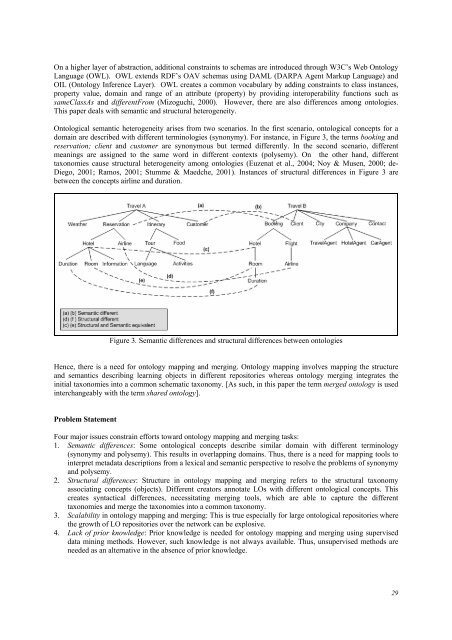July 2006 Volume 9 Number 3 - CiteSeerX
July 2006 Volume 9 Number 3 - CiteSeerX
July 2006 Volume 9 Number 3 - CiteSeerX
You also want an ePaper? Increase the reach of your titles
YUMPU automatically turns print PDFs into web optimized ePapers that Google loves.
On a higher layer of abstraction, additional constraints to schemas are introduced through W3C’s Web Ontology<br />
Language (OWL). OWL extends RDF’s OAV schemas using DAML (DARPA Agent Markup Language) and<br />
OIL (Ontology Inference Layer). OWL creates a common vocabulary by adding constraints to class instances,<br />
property value, domain and range of an attribute (property) by providing interoperability functions such as<br />
sameClassAs and differentFrom (Mizoguchi, 2000). However, there are also differences among ontologies.<br />
This paper deals with semantic and structural heterogeneity.<br />
Ontological semantic heterogeneity arises from two scenarios. In the first scenario, ontological concepts for a<br />
domain are described with different terminologies (synonymy). For instance, in Figure 3, the terms booking and<br />
reservation; client and customer are synonymous but termed differently. In the second scenario, different<br />
meanings are assigned to the same word in different contexts (polysemy). On the other hand, different<br />
taxonomies cause structural heterogeneity among ontologies (Euzenat et al., 2004; Noy & Musen, 2000; de-<br />
Diego, 2001; Ramos, 2001; Stumme & Maedche, 2001). Instances of structural differences in Figure 3 are<br />
between the concepts airline and duration.<br />
Figure 3. Semantic differences and structural differences between ontologies<br />
Hence, there is a need for ontology mapping and merging. Ontology mapping involves mapping the structure<br />
and semantics describing learning objects in different repositories whereas ontology merging integrates the<br />
initial taxonomies into a common schematic taxonomy. [As such, in this paper the term merged ontology is used<br />
interchangeably with the term shared ontology].<br />
Problem Statement<br />
Four major issues constrain efforts toward ontology mapping and merging tasks:<br />
1. Semantic differences: Some ontological concepts describe similar domain with different terminology<br />
(synonymy and polysemy). This results in overlapping domains. Thus, there is a need for mapping tools to<br />
interpret metadata descriptions from a lexical and semantic perspective to resolve the problems of synonymy<br />
and polysemy.<br />
2. Structural differences: Structure in ontology mapping and merging refers to the structural taxonomy<br />
associating concepts (objects). Different creators annotate LOs with different ontological concepts. This<br />
creates syntactical differences, necessitating merging tools, which are able to capture the different<br />
taxonomies and merge the taxonomies into a common taxonomy.<br />
3. Scalability in ontology mapping and merging: This is true especially for large ontological repositories where<br />
the growth of LO repositories over the network can be explosive.<br />
4. Lack of prior knowledge: Prior knowledge is needed for ontology mapping and merging using supervised<br />
data mining methods. However, such knowledge is not always available. Thus, unsupervised methods are<br />
needed as an alternative in the absence of prior knowledge.<br />
29

















